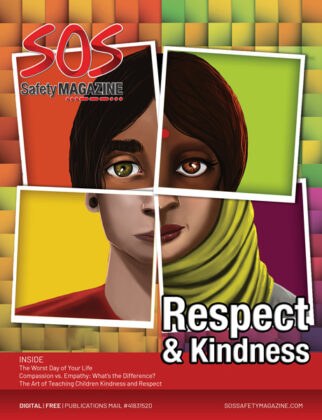ARTICLES, INTERNET SAFETY. FACTS ABOUT CYBER BULLYING
Expert Shares 3 Key Ways To Keep Your Children Safe Online


Before we get into any specific tips on how you can help keep your children safe online, lets put this topic in perspective. Technology is a significant part of our lives and our children’s lives, and that can be both a great thing and a bad thing.
There’s no doubt technology has made it easier to stay in touch with friends, especially those we might not otherwise see. Plenty of games have educational value and have created fun ways for children to learn without realising they’re even doing so. And simple arrangements like meeting someone at a public place are much easier with the use of phones when we’re out and about.
There’s also no doubt technology, or more specifically the way it’s used, has led to higher levels of anxiety, stress, depression, and suicide. Cyberbullying and sexting are two of the biggest concerns most parents have, with image-based abuse becoming more and more common. As such, the act of giving your child their first smartphone has become a terrifying prospect for many parents!
So what’s the answer then? Hiding your children from technology, although at times tempting, is not only a futile exercise but can also put them in more danger than exposing them to it (to a somewhat limited extent). Not only that, it will prohibit their growth and development in a world where there’s a very good chance they’ll need to be tech-savvy during their career. Furthermore, prohibition doesn’t give them the chance to learn how to use technology safely and become resilient to its pitfalls.
Whilst we don’t need our children to be exposed to everything the internet has to offer, particularly at a very young age (it’s hard to imagine how an adult can possibly benefit from seeing a beheading or porn online, let alone a child!), they are going to be spending much of their childhood online. That being said, our role is to teach them to use the internet safely and responsibly – no simple task by any means!
The following tips will help you start off in the right direction in guiding your children to be responsible digital citizens.
1. Keep Devices Out Of Bedrooms
I’m sure you’ve heard this one before, and it’s easy to do when your children are using computers. But when they use more mobile devices such as i-pads or tablets and phones, this becomes more challenging. Many determined children will hide the fact that they have devices in their bedroom while their parents are otherwise occupied and oblivious to what they’re doing.
One of the main reasons for this particular tip is that bad things happen in private. The classic example is sexting – would your child strip off in the loungeroom of your home to take a sext?
Back in 2014 according to a MediaSmarts survey of 5,436 students in Canada ranging from grades 4 to 11, over one-third of students (36%) had received a sext, and 15% had sent one. I’d be willing to bet my bottom dollar the numbers of teens who are sexting have grown significantly since then – most teens accept it as common practice and see it as no big deal.
But sexting IS a big deal. Sexting can lead to image-based abuse, with images being used and widely spread without consent. It leads to bullying, often quite severe. It also leads to extortion and sextortion (demanding children to engage in more sexual acts in the hope that their initial image or video doesn’t get distributed). Following this tip and keeping devices out of bedrooms can help prevent your child from engaging in sexting.
2. Randomly Check Devices
This idea is controversial, as tweens and teens like their privacy and most parents are understandably hesitant to violate their child’s perceived right to privacy. In order to check your child’s device without World War Three breaking out in your home, it’s important to go about this in the right way. That means agreeing up-front before your child even has their phone that you have the right at any time to check what’s happening there, ideally with them present. You’re not “spying” on them behind their back because you don’t trust them; rather you’re keeping an eye on their phone to help guide them and keep them safe.
It’s important also that you check their phone randomly, not at the same time each week. It’s not that you’re waiting to pounce on them doing the wrong thing, but you don’t want them hiding their activity in preparation for you. You want the real picture, which may mean checking their phone when they least expect it.
Ultimately this is a decision for you to make. Having read too many stories from parents whose children were groomed by predators, who were either killed or committed suicide as a result of online activities the parents knew nothing about, I would always choose safety over privacy. It’s the lesser of two evils. A child who’s annoyed with the way you care for them has it all over a child who is no longer alive to be angry with you.
3. Teach Your Child What Their Personal Information Is
Your child has probably been told not to share their personal information online. But most are not fully aware of what constitutes their personal information! They’ll know it includes their home address and their phone number, but there’s a whole long list of other personal information they’re likely to share without realising it. It doesn’t take much for someone to look at an image of a child in a sports uniform and physically locate them at a particular time and place. Or to put together information about a child after seeing a picture of their bedroom.
The other part to discouraging your child from sharing personal information is to explain to them WHY they shouldn’t share it. Children are used to being told what not to do, and they often just tune out to this type of instruction. Understanding the reasoning behind it and how it can impact them will go a long way towards preventing them from wanting to do anything that can prove detrimental to their personal safety.
There’s So Much More…
Before writing this post I had intended to list ten ways you can help keep your children safe online, but I didn’t anticipate how long it would take to read! We are really just barely scratching the surface here in terms of what it actually takes to keep your children safe online. It’s a very complex issue without a quick and simple answer – which is of course why it poses so much of a problem for so many of us.
For more information on how you can keep your children safe online check out the Peaceful Digital Parenting Solution. It’s the easiest way I know to get the information you need in the shortest possible time.
Also if you’d like the other seven ways to help keep your children safe online just comment below, and hopefully I’ll be back with more!
** To read Part II, click here.
About the Author
 Ruth Dearing is the founder of Children and Technology, a public speaker, international best-selling author of “How To Keep Your Children Safe Online…And Put An End To Internet Addiction”, and a mother of two. Her expertise and passion lies in helping parents keep their children safe online.
Ruth Dearing is the founder of Children and Technology, a public speaker, international best-selling author of “How To Keep Your Children Safe Online…And Put An End To Internet Addiction”, and a mother of two. Her expertise and passion lies in helping parents keep their children safe online.
–
–







